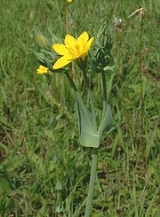
Blackstonia perfoliata
Encyclopedia
Blackstonia perfoliata or yellow-wort is a species
of plant in the family Gentianaceae
found around the Mediterranean Basin
, but extending into northwestern Europe
.
Pathogens affecting B. perfoliata include Peronospora
chlorae.
, being united at the base. It bears terminal cymes of bright yellow, stalked flowers, one to one and a half centimetres across. The calyx is deeply divided into 6-10 linear lobes or sepal
s, spirally arranged, free or nearly free from each other at the base and shorter than the corolla. The petal
s number six to ten and form a short tube. There are six to ten adherent stamen
s and a two-lobed stigma
.
Species
In biology, a species is one of the basic units of biological classification and a taxonomic rank. A species is often defined as a group of organisms capable of interbreeding and producing fertile offspring. While in many cases this definition is adequate, more precise or differing measures are...
of plant in the family Gentianaceae
Gentianaceae
Gentianaceae are a family of flowering plants of 87 genera and over 1500 species. Flowers are actinomorphic and bisexual with fused sepals and petals. The stamens are attached to the inside of the petals and alternate with the corolla lobes. There is a glandular disk at the base of the gynoecium,...
found around the Mediterranean Basin
Mediterranean Basin
In biogeography, the Mediterranean Basin refers to the lands around the Mediterranean Sea that have a Mediterranean climate, with mild, rainy winters and hot, dry summers, which supports characteristic Mediterranean forests, woodlands, and scrub vegetation...
, but extending into northwestern Europe
Europe
Europe is, by convention, one of the world's seven continents. Comprising the westernmost peninsula of Eurasia, Europe is generally 'divided' from Asia to its east by the watershed divides of the Ural and Caucasus Mountains, the Ural River, the Caspian and Black Seas, and the waterways connecting...
.
Pathogens affecting B. perfoliata include Peronospora
Peronospora
Peronospora is a genus of plant pathogens, belonging to the class of water moulds. Water moulds are not true fungi since they belong to the kingdom of chromalveolates....
chlorae.
Description
Yellow-wort grows from ten to fifty centimetres, (four to twenty inches), tall with stiff, branching stems. The leaves are glaucous, opposite and entire, the upper ones perfoliateLeaf shape
In botany, leaf shape is characterised with the following terms :* Acicular : Slender and pointed, needle-like* Acuminate : Tapering to a long point...
, being united at the base. It bears terminal cymes of bright yellow, stalked flowers, one to one and a half centimetres across. The calyx is deeply divided into 6-10 linear lobes or sepal
Sepal
A sepal is a part of the flower of angiosperms . Collectively the sepals form the calyx, which is the outermost whorl of parts that form a flower. Usually green, sepals have the typical function of protecting the petals when the flower is in bud...
s, spirally arranged, free or nearly free from each other at the base and shorter than the corolla. The petal
Petal
Petals are modified leaves that surround the reproductive parts of flowers. They often are brightly colored or unusually shaped to attract pollinators. Together, all of the petals of a flower are called a corolla. Petals are usually accompanied by another set of special leaves called sepals lying...
s number six to ten and form a short tube. There are six to ten adherent stamen
Stamen
The stamen is the pollen producing reproductive organ of a flower...
s and a two-lobed stigma
Stigma (botany)
The stigma is the receptive tip of a carpel, or of several fused carpels, in the gynoecium of a flower. The stigma receives pollen at pollination and it is on the stigma that the pollen grain germinates. The stigma is adapted to catch and trap pollen with various hairs, flaps, or sculpturings...
.

